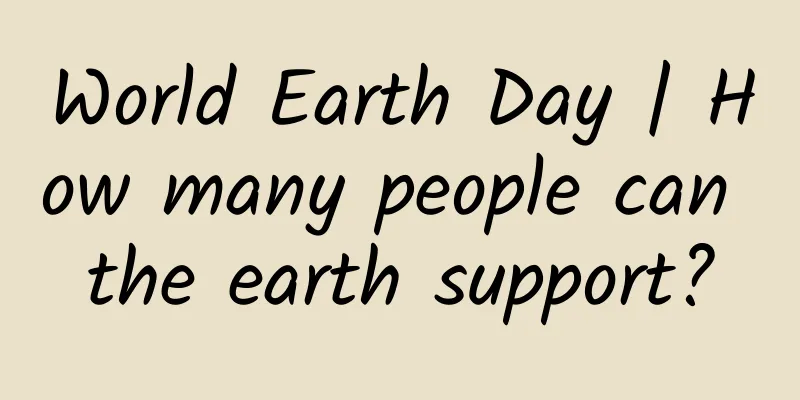World Earth Day | How many people can the earth support?

|
As early as 2012, the academic journal Journal of Sustainable Agriculture published an editorial pointing out that at that time, the world had enough food for 10 billion people. In 2015, the United Nations adopted a resolution entitled "Transforming Our World: The 2030 Agenda for Sustainable Development". The second goal of sustainable development pointed out that by 2030, hunger should be eliminated worldwide, food security should be achieved, nutrition should be improved, and sustainable agriculture should be promoted. At that time, setting this goal seemed to be easily accomplished, but the 2022 report of the Food and Agriculture Organization of the United Nations pointed out that by 2030, there will still be 670 million hungry people in the world, accounting for 8% of the world's population. Compared with 2015, it cannot be said to have decreased significantly, but it can be said that it has basically remained unchanged. So what is the problem? How many people can the earth carry? First of all, production should not be a problem. With the widespread application of advanced agricultural technology, global crop yields have increased significantly. If we only consider the average daily intake of 2,000 calories per person, the current food production is not only sufficient, but also abundant. The US Environmental Protection Agency pointed out that the biggest problem with the US food system is waste. 30-40% of the food produced is not eaten but wasted, and 1.3 billion tons of food are lost worldwide every year due to waste. However, production can also be a problem, because the nutritional value and production cost or economic benefits of different foods are different. If people all over the world eat Manchu Han Banquet every day, there will definitely be a shortage of food. The current modern agricultural system has too many crop types. 60% of people's dietary energy supply comes from only three crops: rice, corn and wheat, which has led to one-third of the population suffering from some degree of malnutrition. If we set the production target to healthy diet, then the number of people in the world who cannot afford a healthy diet in the real world is close to 3.1 billion, which is not optimistic. The picture comes from Tuchong.com Secondly, environmental pollution and damage also affect the earth's population carrying capacity. Greenhouse gas emissions will affect the earth's population carrying capacity at multiple levels, and increasingly frequent and severe extreme climate events will increase the cost of agricultural production. At the same time, climate change will also change the quality of crops. For example, a study by Harvard University pointed out that when major crops are exposed to atmospheric carbon dioxide concentrations predicted in 2050, they will lose 10% of zinc, 5% of iron and 8% of protein. This change in nutrient composition will ultimately affect people's nutritional intake. In addition, environmental pollution will affect the total amount of land resources available for farming, and will also affect the trend of extending life expectancy through public health issues such as chronic diseases, all of which will ultimately affect the earth's population carrying capacity. Finally, the biggest but often overlooked impact is the transformation of the global agricultural food system. Currently, global government support for food and agriculture has reached $630 billion. Developed countries have heavily subsidized agriculture, and with the help of advanced technology, their production costs are actually lower. In 2020, the global average cost of a healthy diet was $3.54 per person per day, and high-income countries only cost $3.35 per person per day. However, this subsidy focuses more on grain production, which promotes food security in terms of providing calories, but it is not very effective in improving nutrition and health. Therefore, it is still necessary to provide people with affordable healthy diets at a lower cost. However, we can also think about this problem from the opposite direction, that is, will our population reach the upper limit of carrying capacity? The hot topic of social discussion at the beginning of this year was that my country's population had already experienced negative growth last year. From a global perspective, there is currently no modern country whose population fertility rate has been able to rise after falling below 2.1. In other words, with the development of the global economy, the global population itself has an upper limit. There are many prediction models in the academic community at present, and the most pessimistic one believes that this upper limit will not even exceed 10 billion. It is very likely that the world population will stagnate or even decline before reaching the upper limit of carrying capacity, which is actually more difficult to deal with than increasing the upper limit of the earth's carrying capacity. We may face social problems brought about by an aging population and a low birth rate at the same time. If the population declines fast enough and technology does not keep up, there may even be a problem of a decline in the existing earth's carrying capacity due to labor shortages and insufficient production. Currently, there are only two policy solutions to solve the problem of population decline worldwide: either provide more fertility subsidies and tax incentives, or absorb immigrants. Developed countries that first encountered population decline problems often have to use both methods to barely maintain their population size. Even Japan, which has traditionally opposed immigration, has recently relaxed immigration conditions to cope with the problem of domestic labor shortages. Another invisible solution is to promote technological progress and replace manual labor with automated machines, which can at least maintain the current production capacity or carrying capacity and ensure that the current living standards of people do not decline. Perhaps when productivity is sufficiently developed, the social pressure caused by modernization will be reduced, and the population will gradually recover after the cost of childbirth is reduced to a certain level. In short, the carrying capacity of the earth depends on the level of social productivity, environment and policies. At present, the total carrying capacity is sufficient but the distribution is not equal. It is necessary to improve the quality and utilization efficiency of dietary health, and population changes themselves will also have an impact on the carrying capacity. This article is a work supported by Science Popularization China Starry Sky Project Author: Yu Miao (Associate Computer Scientist at Jackson Laboratory, USA) Reviewer: Yang Laisheng (Researcher at Lanzhou Academy of Agricultural Sciences) Produced by: China Association for Science and Technology Department of Science Popularization Producer: China Science and Technology Press Co., Ltd., Beijing Zhongke Xinghe Culture Media Co., Ltd. |
<<: Beware! There are multiple disease signals hidden behind these three major sleep problems!
>>: World Earth Day: Forest "Carbon Pool" Paints a Beautiful China
Recommend
Mycoplasma pneumonia positive = Mycoplasma pneumonia? In the high season of respiratory infectious diseases, don’t miss this article
gossip Autumn and winter are the peak seasons for...
From amazing to declining: Two years of Google Glass
Apart from Google Glass, there may be no other cu...
Why are some dreams always so strange? Maybe it has something to do with it…
Alice chases a rabbit with a pocket watch and ent...
Can you spend one dollar in channel fees as if it were eight dollars? Let's look at the Six Meridians Divine Sword
What changes have taken place in the way communic...
Nanchang’s severe convective weather has become a hot topic. Is such severe weather normal in spring?
Recently, severe convective weather has occurred ...
Bringing the "sky" to the ground, he "blasted" a new path for Chinese wind tunnels
"I think the country is so poor, can you spe...
How much does it cost to attract investment for the Lincang Transportation Mini Program? What is the investment price for the Lincang Transportation Mini Program?
How much does it cost to attract investment for t...
Can salmon be grown using cells? There is a new choice for future food!
If one day people were to live on the uninhabited...
My parents don’t allow me to drink raw water. What’s the “ghost” hidden in it?
Water is the source of life. It maintains body fl...
How to use Foshan WeChat public account lottery mini program? How much does it cost to create a WeChat lottery app?
Before we know it, another year has passed, and m...
Some people are alive, but their butts are already "dead"...
Work, work, I sit when I go to work, sit all day,...
Black workers: 90s bees cloned into a million-strong army, almost subverting the South African beekeeping industry
More, more, more. Written by | Krestrel Honey bee...
China Automobile Dealers Association: China's passenger car sales in the first quarter of 2022 were 4.894 million, down 9.8% year-on-year
In the first quarter of 2022 , domestic passenger...
Windows becomes open source software? Microsoft executives say it's possible
[[131206]] According to InfoWorld, after Microsof...
Found it! The tomb of Zhang Zhao, an important official of the Three Kingdoms, is in Nanjing
Recently, the "Academic Symposium to Commemo...









